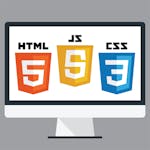Javascript Cheat Sheet
This cheat sheet is a valuable resource for anyone who wants to learn JavaScript. It is a quick and easy way to learn about the most common JavaScript syntax, functions, and concepts, and it can help you to build interactive and dynamic web pages.
JavaScript is a universal programming language primarily used for client-side web development. It allows you to add interactivity, manipulate web page elements, handle events, and perform various operations on the browser. By referring to a JavaScript cheat sheet, you can quickly grasp the language's essential syntax, functions, and concepts. This will empower you to write code that can respond to user actions, validate input, create animations, and dynamically update web page content, enhancing your web applications' overall user experience.
Javascript Cheat Sheet
This cheat sheet is a valuable resource for anyone who wants to learn JavaScript. It is a quick and easy way to learn about the most common JavaScript syntax, functions, and concepts, and it can help you to build interactive and dynamic web pages.
JavaScript is a universal programming language primarily used for client-side web development. It allows you to add interactivity, manipulate web page elements, handle events, and perform various operations on the browser. By referring to a JavaScript cheat sheet, you can quickly grasp the language's essential syntax, functions, and concepts. This will empower you to write code that can respond to user actions, validate input, create animations, and dynamically update web page content, enhancing your web applications' overall user experience.
Javascript quick reference cheat sheet
Variables:
var, let, const: Keywords to declare variables with different scoping rules.
Explanation: Variables are used to store and manipulate data in JavaScript. The var keyword has function scope, let has block scope, and const declares a constant variable.
Example: var x = 5; // x is accessible within the function it's declared in
let y = 10; // y is accessible only within the block it's declared in
const z = 15; // z is a constant variable that cannot be reassigned
Data Types:
String: Represents textual data.
Explanation: Strings are sequences of characters enclosed in single or double quotes.
Example: let name = "John";
Number: Represents numeric data.
Explanation: Numbers can be whole numbers or decimal numbers.
Example: let age = 25;
Boolean: Represents either true or false.
Explanation: Booleans are used to represent logical values.
Example: let isStudent = true;
Array: Represents an ordered collection of values.
Explanation: Arrays allow you to store multiple values in a single variable.
Example: let numbers = [1, 2, 3, 4, 5];
Object: Represents a collection of key-value pairs.
Explanation: Objects allow you to store related data as properties and their values.
Example: let person = { name: "John", age: 25 };
Operators:
Arithmetic Operators: Perform arithmetic operations.
Explanation: Arithmetic operators are used for basic math calculations.
Example: let sum = 5 + 3; (sum will be 8)
Assignment Operators: Assign values to variables.
Explanation: Assignment operators are used to assign values to variables.
Example: let x = 10; (x will be 10)
Comparison Operators: Compare values.
Explanation: Comparison operators compare values and return a boolean result.
Example: let isGreater = 5 > 3; (isGreater will be true)
Logical Operators: Perform logical operations.
Explanation: Logical operators are used to combine or negate boolean values.
Example: let isTrue = true && false; (isTrue will be false)
String Concatenation: Concatenates strings.
Explanation: The + operator is used to concatenate strings.
Example: let fullName = "John" + " Doe"; (fullName will be "John Doe")
Control Flow:
Conditional Statements:
if statement: Executes a block of code if a condition is true.
Explanation: The if statement allows you to perform different actions based on different conditions.
Example: if (age >= 18) { console.log("You are an adult."); } else { console.log("You are a minor."); }
switch statement: Executes different blocks of code based on different cases.
Explanation: The switch statement allows you to choose one of many code blocks to be executed.
Example: switch (day) { case "Monday": console.log("Today is Monday."); break;
Loops:
for loop: Executes a block of code repeatedly for a specified number of times.
Explanation: The for loop allows you to iterate over a block of code a specific number of times.
Example: for (let i = 0; i < 5; i++) { console.log(i); }
while loop: Executes a block of code repeatedly as long as a condition is true.
Explanation: The while loop repeatedly executes a block of code as long as a given condition is true.
Example: while (count < 10) { console.log(count); count++; }
Functions:
Declaration: Define reusable blocks of code.
Explanation: Functions allow you to define reusable blocks of code that can be called multiple times.
Example: function greet(name) { console.log("Hello, " + name + "!"); }
Arrow Functions: A concise syntax for defining functions.
Explanation: Arrow functions provide a shorter syntax for writing functions, especially useful for one-liners.
Example: const sum = (a, b) => a + b;
Arrays:
Array Methods:
push(): Add elements to the end of an array.
pop(): Remove the last element of an array.
length: Get the length of an array.
Explanation: Arrays have built-in methods that allow you to manipulate and retrieve data.
Example: let numbers = [1, 2, 3]; numbers.push(4); // Adds 4 to the end of the array console.log(numbers.length); // Outputs 4
Objects:
Object Properties: Accessing and modifying object properties.
Explanation: Objects have properties that can be accessed and modified using dot notation or bracket notation.
Example: let person = { name: "John", age: 25 }; console.log(person.name); // Outputs "John" person.age = 30; // Modifies the age property
String Methods:
length: Get the length of a string.
toUpperCase(): Convert a string to uppercase.
toLowerCase(): Convert a string to lowercase.
Explanation: Strings have built-in methods that allow you to perform operations and manipulations.
Example: let greeting = "Hello, World!"; console.log(greeting.length); // Outputs 13 console.log(greeting.toUpperCase()); // Outputs "HELLO, WORLD!"
Error Handling:
try, catch, finally: Handle and manage errors in JavaScript.
Explanation: Error handling allows you to catch and handle exceptions that occur during the execution of your code.
Example: try { // Code that may throw an error } catch (error) { // Code to handle the error } finally { // Code that runs regardless of whether an error occurred }
Learn more Javascript skills on Coursera.
JavaScript Courses | Web Development Courses | Node.Js Courses | MongoDB Courses | CSS Courses | React JS Courses | HTML Courses | Front End Web Development Courses
 Join a community of over 100 million learners from around the world
Join a community of over 100 million learners from around the world Learn from more than 200 leading universities and industry educators.
Learn from more than 200 leading universities and industry educators. 70% of all learners who have stated a career goal and completed a course report outcomes such as gaining confidence, improving work performance, or selecting a new career path.
70% of all learners who have stated a career goal and completed a course report outcomes such as gaining confidence, improving work performance, or selecting a new career path.- 100% online
- Flexible schedule
- Mobile learning
- Videos and readings from professors at world-renowned universities and industry leaders
- Practice quizzes
Can’t decide what is right for you?
Try the full learning experience for most courses free for 7 days.Register to learn with Coursera’s community of 87 million learners around the world






